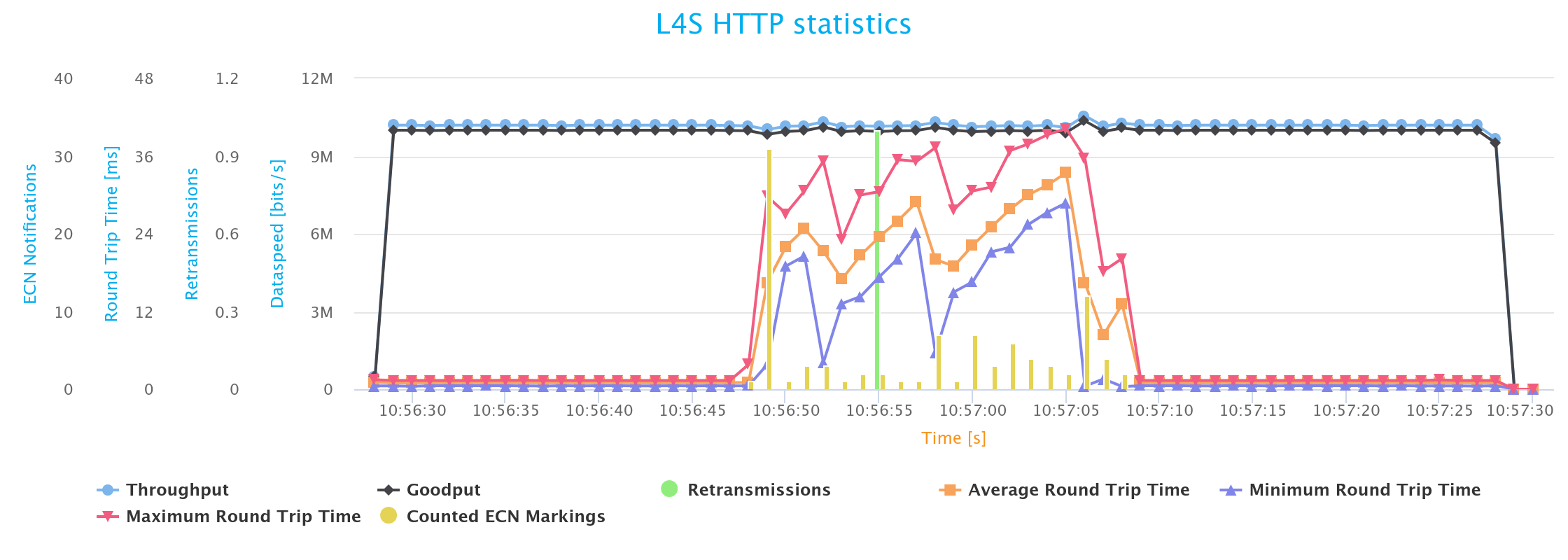Overview
Introduction
This test case allows perform traffic testing for low latency validation. It makes use of the features of the ByteBlower Test Framework.
Analysis of the impact for the end user.

This ByteBlower low latency test case allows you to:
Easily configure your test setup and flows using a JSON configuration file.
Run different and customized, at your likings, flows to test a variety of low latency related scenarios
Test Low Latency DOCSIS (LLD) and Low Latency, Low Loss, Scalable throughput (L4S) capable traffic
Collect & summarize latency and frame loss results analysis
Generate HTML, JUnit XML and JSON reports with graphs and result summaries
Different types of flows can be defined between one or more source and destination ports (traffic endpoints). Both UDP/TCP traffic is supported, allowing to simulate different types of applications such as: Voice calls, video streaming, gaming, conference calls, HTTP requests, etc.
You know all about low latency, LLD and L4S testing and you are thrilled to run the test? Then you can immediately jump to our Installation & Quick start.
Low Latency Traffic
Low latency refers to the minimal delay experienced in data transmission over a network. It is a crucial factor to improve user’s Quality of Experience (QoE) for a wide range of applications, particularly those that demand real-time interactions. Such applications allow a smoother, more responsive experience, minimizing delays and ensuring that user actions are promptly reflected in the application’s output. These applications include:
Video Conferencing and Streaming
Online Gaming
Video streaming
Real-time Collaboration
Voice calls
Achieving low latency in networks requires a combination of techniques, including the use of high-speed network infrastructure, content delivery networks (CDNs), data compression, efficient routing algorithms, network optimization tools, edge computing, and prioritization of time-sensitive traffic.
Low Latency DOCSIS (LLD) and Low Latency, Low Loss, Scalable throughput (L4S) are two technologies that can be used to improve low latency in networks.
Low Latency DOCSIS (LLD)
Low Latency DOCSIS technology (LLD) represents a specification jointly developed by CableLabs, DOCSIS vendors, and cable operators. Low Latency DOCSIS operates over Hybrid Fiber-Coaxial HFC cable networks.It addresses network latency by targeting queuing delay and media acquisition delay. LLD allows data traffic from non-latency-inducing applications to navigate a distinct logical path through the DOCSIS network, preventing it from being delayed by latency-causing applications, as the case in current Internet architectures. This method preserves fair bandwidth sharing among applications without compromising one’s latency for the benefit of others.
Additionally, LLD enhances DOCSIS upstream media acquisition delay by employing a faster request-grant loop and a new proactive scheduling mechanism. The overall result is an improved internet experience for latency-sensitive applications, without adversely affecting other applications.
Low Latency, Low Loss, Scalable throughput (L4S)
L4S is a new technology that improves the performance of Internet applications that need both high speed and low delay. L4S is technology agnostic and can be applied to any communication technology, such as 5G, Wi-Fi, cable or fiber networks.
L4S is based on the insight that the root cause of queuing delay is in the capacity-seeking congestion controllers of senders, not in the queue itself. L4S defines new rules for the Internet congestion controls (Prague requirements), inspired by Data Center TCP (DCTCP). L4S Prague changes how network bottlenecks signal congestion, and how senders react to those signals, compared to classic TCP.
Where classic TCP relies on packet losses to detect congestion, L4S Prague uses a bit in the IP header as an explicit congestion signal. That bit is called Explicit Congestion Notification (ECN). Early and frequent congestion notifications are sent to the sender before the queue begins to fill, this allows the sender to adjust his sending rate more quickly and accurately.